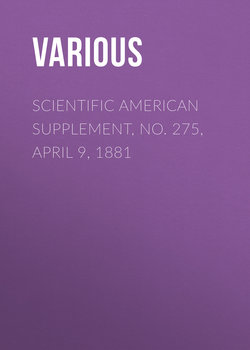Читать книгу Scientific American Supplement, No. 275, April 9, 1881 - Various - Страница 5
WHEAT AND WHEAT BREAD
ENDOSPERM OR FLOURY PORTION, NOS. 7, 8, 9
ОглавлениеThis portion is composed of large glutinous cells, in which the granules of starch are found. The composition of these different layers offers a particular interest; the center, No. 9, is the softest part; it contains the least gluten and the most starch; it is the part which first pulverizes under the stone, and gives, after the first bolting, the fine flour. As this flour is poorest in gluten, it makes a dough with little consistency, and incapable of making an open bread, well raised. The first layer, No. 8, which surrounds the center, produces small white middlings, harder and richer in gluten than the center; it bakes very well, and weighs 20 lb. in 100, and it is these 20 parts in 100 which, when mixed with the 50 parts in the center, form the finest quality flour, used for making white bread.
The layer No. 7, which surrounds the preceding one, is still harder and richer in gluten; unfortunately in the reduction it becomes mixed with some hundredth parts of the bran, which render it unsuitable for making bread of the finest quality; it produces in the regrinding lower grade and dark flours, together weighing 7 per cent. The external layer, naturally adhering to the membrane, No. 6, becomes mixed in the grinding with bran, to the extent of about 20 per cent., which renders it unsuitable even for making brown bread; it serves to form the regrindings and the offals destined for the nourishment of animals; this layer is, however, the hardest, and contains the largest quantity of gluten, and it is by consequence the most nutritive. We now see the endosperm increasing from the center, formed of floury layers, which augment in richness in gluten, in proportion as they are removed from the center. Now, as the flours make more bread in proportion to the quantity of gluten they contain, and the gluten gives more bread in proportion to its being more developed, or having more consistence, it follows that the flour belonging to the parts of the berry nearest the envelopes or coverings should produce the greatest portion of bread, and this is what takes place in effect. The product of the different layers of the endosperm is given below, and it will be seen that the quantity of bread increases in a proportion relatively greater than that of the gluten, which proves once more that the gluten of the center or last formation has less consistence than that of the other layers of older formation.
The following are the results obtained from the same wheat:
On the whole, it is seen, according to the composition of the floury part of the grain, that the berry contains on an average 90 parts in 100 of flour fit for making bread of the first quality, and that the inevitable mixing in of a small quantity of bran reduces these 90 to 70 parts with the ordinary processes; but the loss is not alone there, for the foregoing table shows that the best portion of the grain is rejected from the food of man that brown or dark bread is made of flour of very good quality, and that the first quality bread is made from the portion of the endosperm containing the gluten in the smallest quantity and in the least developed form.
This is a consideration not to be passed over lightly; assuredly the gluten of the center contains as much azote as the gluten of the circumference, but it must not be admitted in a general way that the alimentary power of a body is in connection with the amount of azote it contains, and without entering into considerations which would carry us too wide of the subject, we shall simply state that if the flesh of young animals, as, for instance, the calf, has a debilitating action, while the developed flesh of full-grown animals–of a heifer, for example–has really nourishing properties, although the flesh of each animal contains the same quantity of azote, we must conclude that the proportion of elements is not everything, and that the azotic or nitrogenous elements are more nourishing in proportion as they are more developed. This is why the gluten of the layers nearest the bran is of quite a special interest from the point of view of alimentation and in the preparation of bread.
